Sapota Farming (or) Chiku Farming Info Guide:
The following article is about ” Sapota Farming (Chikoo)” or “How to grow Chikoo Fruit”.
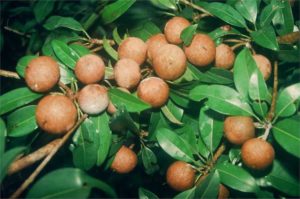
About Sapota:
Sapota fruit is a native of Mexico and other tropical countries of South America. Sapota commonly known as Chiku fruit is mainly cultivated in India for its fruit value, while in South-East Mexico, Guatemala and other countries it is commercially grown for the production of chickle which is a gum-like substance obtained from latex and is mainly used for the preparation of chewing gum. In India, It has become a very popular fruit crop in Gujarat, Maharashtra, Karnataka, Tamilnadu, Andhra Pradesh, and Kerala.
Varieties cultivated in different states of India:
| State in India | Varieties of Sapota grown | |
| Andhra Pradesh | – | Cricket ball, Kalipatti, Calcutta round, Kirthibharathi, Dwarapudi, Pala, PKM-1, Jonnavalasa I & II, Bangalore, Vavi Valsa |
| Bihar | – | Baramasi |
| Gujarat | – | Kalipatti, Pilipatti, Cricket Ball, PKM-1 |
| Karnataka | – | Cricket ball, Kalipatti, Calcutta round, DHS-1, DHS-2 |
| Maharashtra | – | Kalipatti, Dhola Diwani, Cricket ball, Murabba |
| Orissa | – | Cricket ball, Kalipatti |
| Tamil Nadu | – | Pala, Cricket ball, Guthi, Co 1, Co 2, PKM-1 |
| Uttar Pradesh | – | Baramasi |
| West Bengal | – | Cricket ball, Calcutta round, Baramasi, Baharu, Gandhevi Barada |
Suitable soil for Sapota plantation:
Sapota fruit can be grown in a variety of soils but deep alluvium, sandy loam, and well-drained medium black soils with pH 6.0-8.0 are ideal for sapota farming. However, shallow clay soils underlaid with hardpan or high calcium contents does not support sapota farming.
Climate required for growing the Sapota fruit:
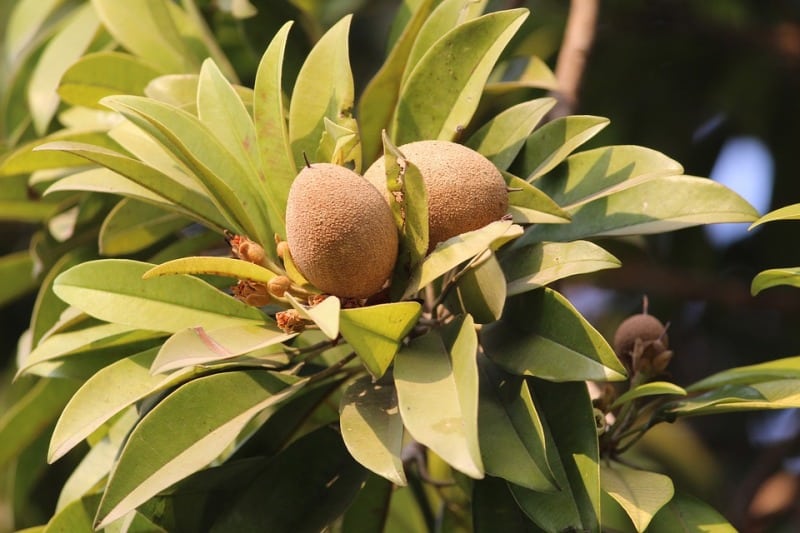
Sapota is a tropical fruit, which likes warm and humid (>70% RH) climate. It grows well up to an altitude of 1, 000m however, coastal climate is ideal for sapota farming. Temperature range of 10-38°C and annual rainfall between 1250-2500 mm is suitable for sapota cultivation where it flowers and fruits throughout the year. Temperatures exceeding 43°C leads to flower drop resulting in a poor crop.
Land preparation methods for Sapota plantation:
The land is ploughed two to three times and then levelled. Undulating land is divided into terraces and levelling is done. Tall and thick growing trees viz. mango, Jamun, tamarind, silver oa, and casuarinas are established on the windward side or on all sides of the orchard. The plants for windbreak may be planted at a distance of 1.5 to 1.8 m. in a row.
Planting material in Sapota crop:
Sapota is commercially propagated by vegetative methods such as air layering or gootee layering, grafting and budding.
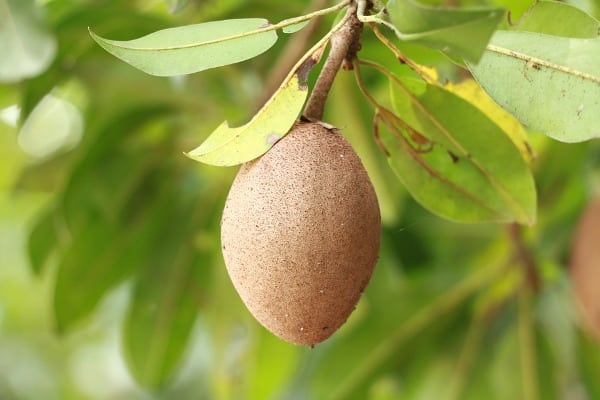
You can read about Watermelon Profits, Yield Per Acre.
The best season for planting Sapota:
Planting can be done in any season provided irrigation facilities are available. Grafts are usually planted at the beginning of the rainy season. In areas where heavy rainfall is present the crop can be planted as late as September.
The spacing of Sapota plants:
The land should be thoroughly plowed at 30-45 cm depth and levelled. Usually planting is done at a distance of 10mx10m. As the growth of sapota plant is slow it takes a longer period to occupy the allocated space. Therefore, a spacing of 6mx6m is maintained until the canopies meet. Subsequently, alternate trees are removed to reduce the plant’s population.
Pit digging for Sapota plantation:
Pits of 90cm3 are opened during the summer and exposed to the sun for a period of 2-3 weeks. While opening the pits, the topsoil and subsoil are to be heaped separately. Each pit is filled with topsoil first followed by subsoil mixed with well-decomposed farmyard manure (FYM), 1kg Superphosphate and 500g Sulphate of potash. Lindane powder @100g/pit is added to control termites.
Sapota planting method:
At the time of planting in the hole, just sufficient to accommodate the root ball of the grafted plant should be dug in the center of the pit. The grafts are planted in the hole in such a way that the graft union remains just above the soil surface. The grafts are staked immediately after planting to protect from strong winds. The young graft is protected from heat by erecting temporary shade covered with grass or plastic sheets.
The polythene strip used for securing the graft joint should be removed a month after planting so as to reduce mortality of the graft. The new sprouts emerging on the rootstock below the graft joint should also be removed immediately.
Irrigation/Drip Irrigation for Sapota plants:
Irrigation is provided at an interval of 30 days in winter and 15 days in summer. This system has been found to be beneficial in saving 40% water with 70-75 % higher income. This system is laid out with 2 drippers spaced 50 cm. from the tree at an initial stage during the first two years and then 4 drippers about 1 m. away from the tree until it attains five years of age.
Inter-cultivation in Sapota orchard:
Intercropping with banana, papaya, pineapple and cocoa; French beans, peas, tomato, brinjal, cabbage, cauliflower, cucurbits is recommended depending upon the climate and irrigation facilities available.
You may read the Smart Farming in India.
How to control weeds in Sapota plantation:
Weeds should be regularly removed from the basin. In young plantations pre-emergence application of Bromacil 2kg a.i./ha or Diuron 2kg a.i./ha has been found effective in controlling the weed population for 10-12 months.
How to prune Sapota plants:
Pruning is normally done during winter to give shape and reduce the overcrowding of branches. Pruning is important as the flowers and fruits are borne on those branches, which receive maximum air sunlight.
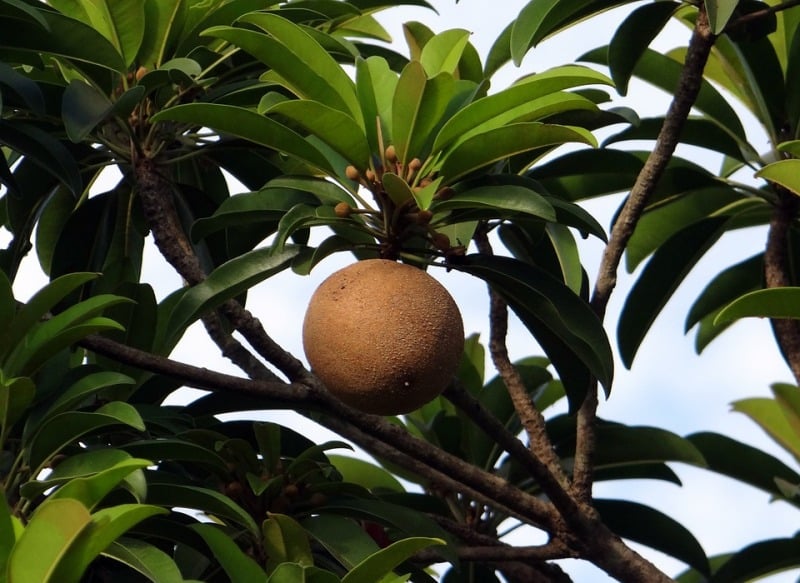
Insect pests and diseases of Sapota:
Most common pests in Sapota Farming are Leaf Webber, hairy caterpillars and budworm . Spraying with phosalone 35 EC (2 ml./l.), chloropyriphos 20 EC or endosulfan 35 EC have been found to be effective in controlling the pests. The main diseases reported are leaf spot (Phleopheospora indica), base rot (Ceratocystis paradoxa), heart rot (Phytophthora parasitica) and anthracnose (Colletotrichum gloeosporioides). Application of Dithane M-45, copper oxychloride (3 g./l.), etc. have been found to be effective.
You may be interested in reading the Sapota Grafting Methods.
Manuring and Fertilization for Spota plants
The nutrient requirement of sapota is very high, as it is an evergreen tree in a continuous state of growth and fruiting. The fertilizer requirement of sapota varies from the age of the tree and soil nutrient status. The recommended fertilizer schedule is as follows -Under rainfed conditions, the nutrient application should be done on the onset of monsoon. However, under irrigated conditions, it should be applied in two splits.
You may be interested in Growing Sapodilla in Containers.
The total quantity of organic manure and half the dose of chemical fertilizers should be applied at the beginning of monsoon and the remaining half in the post-monsoon period (September-October). Since most of the active roots are distributed within the depth of 30cm, nutrients should be applied under the tree canopy and mixed thoroughly in the soil.
Harvesting and the yield of Sapota crop:
Sapota starts bearing from the third year of planting but economic yields can be obtained from 5th year onwards. The two main seasons of flowering are October- November, and February-March and the two corresponding harvesting seasons are January-February and May-June. Sapota takes four months from flowering to maturity of fruits. The fruits are hand-picked or harvested with special harvester which has a round ring with a net bag fixed onto a long bamboo.
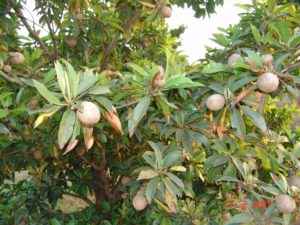
The crop bearing commences from the fifth year. As such intercropping like vegetables may be taken up in the first four years of the project make it viable. In high-density plantation, the production increases from 4.0 tonnes/acre in the fifth year to 6.0 tonnes/acre in the 7th year. Thereafter, the yield stabilizes at 8.0 tonnes/acre from 8th to 15th year.
Post-harvesting of Sapota crop:
Grading:
Grading is mainly based on the size and shape of the fruits. The fruits are graded into three categories depending on their size viz. large, medium and small.
Storage:
The fruits are highly perishable and can be stored under an ordinary condition for a period of 7-8 days after harvesting. At a storage temperature of 200 C, the storage life can be increased for a period of 21-25 days by removing ethylene and adding 5-10% CO2 to storage atmosphere.
The fruits are dipped in GA (300 ppm.) and Bavistin (1000 ppm.) solution at a pre-packing stage in order to extend the storage life of the fruits. Sapota being a climacteric fruit has to be ripened artificially. Unripe fruits can be ripened by applying ethephon (1000 ppm.) at 20-25 0 C and can be stored for five weeks. Ripened ones can be stored at 2-30 C and 90-95% RH for a period of six weeks.
Packaging, transportation, and marketing of Sapota fruits:
For local markets, the graded fruits are packed in bamboo baskets containing straw as padding material. This helps in reducing the bruising and promotes even ripening of fruit. For distant markets fruits are packed in cardboard boxes.
Corrugated trays are equally effective as packaging material while transporting the fruits. Use of such trays is cost effective due to its re-usability. Road transport by trucks/lorries is the most popular mode of transport due to the easy approach from orchards to the market.
Several intermediaries like wholesalers and commission agents are involved in the marketing of the fruit. The farmer realizes around 35% of the wholesale price in the secondary market.
The bottom line of growing Sapota fruits:
Sapota farming is very profitable even for small scale farmers under well farming practices and sapota farming business plan.
Read: How to Grow Moringa from Cuttings, and Seeds.
My chikku plants are thick ., and having too many round gundies but they are not converted in fruits.I am getting green ary only. Let me guide how these can be converted in fruits
Interest in chiku farming